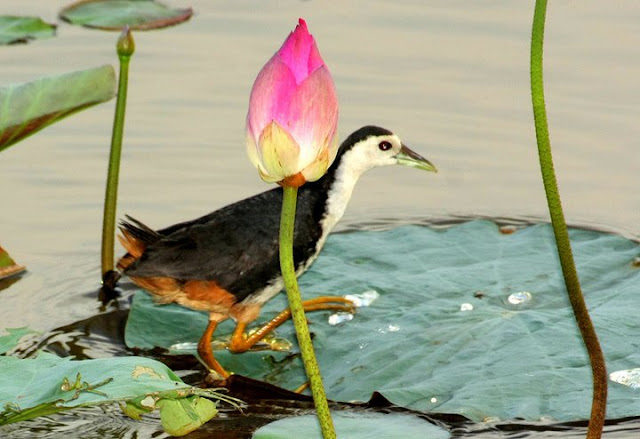 |
| The White-breasted Waterhen (Amaurornis phoenicurus) is a waterbird of the rail and crake family Rallidae that is widely distributed across South and Southeast Asia. They are dark slaty birds with a clean white face, breast and belly. They are somewhat bolder than most other rails and are often seen stepping slowly with their tail cocked upright in open marshes or even drains near busy roads. They are largely crepuscular in activity and during the breeding season after the first rains make loud and repetitive croaky calls. |
 | ||
 |
Behaviour and ecologyThese birds probe with their bill in mud or shallow water, also picking up food by sight. They mainly eat insects, small fish, aquatic invertebrates and seedssuch as those of Pithecolobium dulce.[6] They may sometimes feed in deeper water in the manner of a moorhen.[7][8] They forage on the ground but clamber in low bushes and roost in low trees. |
 |
DescriptionAdult White-breasted Waterhens have mainly dark grey upperparts and flanks, and a white face, neck and breast. The lower belly and undertail are cinnamon coloured. The body is flattened laterally to allow easier passage through the reeds or undergrowth. They have long toes, a short tail and a yellow bill and legs. Sexes are similar, but immature birds are much duller versions of the adults. The downy chicks are black, as with all rails. Several subspecies are named for the populations that are widely distributed. The nominate subspecies is described from Sri Lanka but is often widened to include chinensis of mainland India and adjoining regions in Asia, west to Arabia and east nearly to Japan. The remaining subspecies are those from islands and include insularis of the Andaman and Nicobar Islands, midnicobaricus of the central Nicobars, leucocephala of Car Nicobar, maldivus of the Maldives,javanicus of Java and leucomelanus of Sulawesi and the Lesser Sundas. Location - Paya Indah Wetland |


No comments:
Post a Comment